How Casual Style Became the Foundation of Fashion
Workplace shifts, generational differences and the quest for comfort have all played a role. Plus, take a look at five other hot apparel trends for 2023.
Back in 2005, members of Northwestern University women’s lacrosse team wore flip-flops (albeit fancy rhinestone-bedecked ones) to meet the president for a White House ceremony honoring their NCAA championship. The resulting “flip-flop flap,” as many dubbed it, ruled the news for several days – with the nation debating whether it was a breach of etiquette or just a signal of changing generational tastes.
Fast forward to 2017: Two teens were barred from boarding a United Airlines flight because they were wearing leggings, which went against the airline’s dress code for travelers using an employee pass. The decision set off a firestorm on social media with many decrying what they saw as, at best, an out-of-touch company policy and, at worst, policing of women’s clothing choices.
Then came the pandemic, with its suspension of sartorial norms. Even Anna Wintour – the Vogue editor who once claimed never to wear sweatpants – posted an Instagram pic where she sported red trackpants in her home office. Clearly, the fashion police were off duty during quarantine.
But once the world reopened, it became obvious that COVID had just accelerated an already snowballing trend. Would the flip-flop flap have dominated discourse today the same way it did two decades ago? Has the question of whether leggings are pants been resolved once and for all? Barring a few curmudgeonly holdouts, the answers are no and yes, respectively. Everything is casual now – and that’s not likely to change anytime soon.
“It’s definitely comfort, hands down,” says Julie Crawley, director of product development for Top 40 company. “We became acquainted with our sweatpants and loungewear during COVID, and we don’t want to give them up. We still love style and want to look good in the latest trends, but we consistently look for comfort; any fabric that’s super soft is very appealing.”
And many offices have relaxed their dress codes as a welcoming gesture toward staff, says Catherine Tremblay, director of merchandising for apparel private brands. “Employees continue to see evolving workspace landscapes from different forms of hybrid structures, to varied remote settings,” she says. “Even if a workplace has gone back to completely in-person staffing, it seems that the days of having to ‘dress up’ for the office are all but extinct.”
‘TAILOR-MADE’ FOR THE OFFICE
Athleisure has been the norm outside of the office for years, but it’s only in the aftermath of the pandemic that it’s become completely accepted at work. “Where top management has generally not wanted to compromise on dress codes, that’s now shifted,” says Marcus Davis, product development manager for HanesBrands. “Employers and employees are working to find a middle ground.”

The North End sweater fleece quarter-zip shows how fleece can have a more tailored look.
That could mean trading in joggers for cinched-leg sweats; swapping out hoodies for quarter-zips; or donning a polo instead of a T-shirt, Davis adds. For women, leggings or double-knit stretch pants might be paired with a cardigan for a dressier look. “A button-front loose kind of cardigan concept for a woman is every bit as dressed up as you need to be,” says Vicki Ostrom, a futurist and trend analyst with Top 40 company. “That’s your blazer now.”
Even on notoriously buttoned-up Wall Street, the new work uniform consists of a nice shirt and pants (preferably with some degree of stretch to them), and ties come out only if client meetings are on the agenda, according to a recent New York Times piece on how “business bros” are dressing in their “native habitat.”

Ideal for “workleisure,” this new Comfort Wash garment-dyed quarter-zip is polished enough for the office and relaxed enough for everything else.
Comfort, Crawley notes, doesn’t have to translate to sloppy and disheveled. Instead, she adds, it’s all about the use of “soft, tactile, lightweight fabrics with Lycra that help promote range of movement.”
The term “tailored” itself has taken on a different meaning in this era of dressing. Whereas before it may have conjured up the image of three-piece suits and custom-fitted Oxford button-down shirts (items that were actually altered by a tailor), these days a tailored piece tends to refer simply to embellishments that give a garment a more dressed-up look. “There are these signifiers that bring you to the idea that something is tailored,” Ostrom says. “I’ve noticed this a lot with pants. It could be a jogger made of sweatshirt fleece, but it will have this stitched-down pin tuck all the way down the front, so it makes it look like it’s been pressed into a crease.”

This GapFit hoodie shows how small touches can give fleece an elevated, tailored look.
Metal tipping on drawcords, taping around the zipper and other modern touches can give even a hoodie that tailored touch, says Lauren Cocco, director of merchandising at apparel company. “I would say,” she adds, ‘tailored’ is referring to some sort of elevated detail in the design of the garment.”
REAL WORKWEAR & HUNDRED-DOLLAR HOODIES
One factor in the casualization of fashion is the sustained popularity of workwear – think Carhartt jackets, Dickies pants and old-school Levi’s denim – among the younger generations. They like the rugged aesthetic of these blue-collar brands, and the fact that garments are made of long-lasting fabrics doesn’t hurt.
There’s even an element of sustainability to workwear, Ostrom says. “Just by the fact that it’s such a durable fabric, it will last a long time and that means a lot to young people that you keep it in circularity,” she adds. “I think a lot of them are leaning heavily into workwear for that reason.”
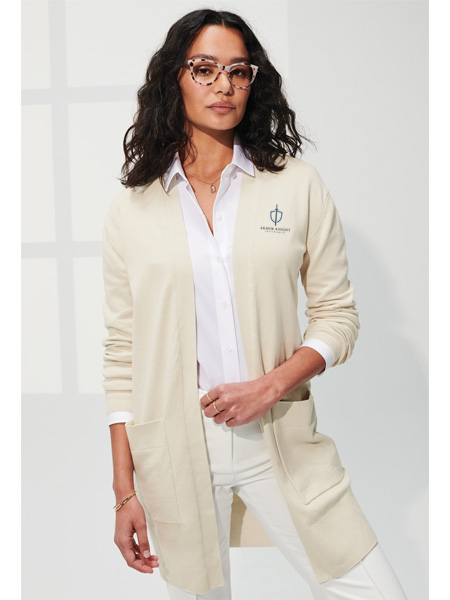
This Mercer+Mettle open front cardigan is a great example of the new office uniform – relaxed, while still looking polished.
Cargo pants and jackets – with their deep, roomy pockets – are also trending. “Utility style,” as Cocco calls it, is hot precisely because of how useful and practical it is for the wearer.
Capitalizing on the trend, Carhartt and other workwear brands have developed more fashion-forward lines, Ostrom says. “It’s their regular workwear, but has a different fit and isn’t quite as oversized,” she adds. “That’s something you could wear more easily in an office situation.”
Another element at play is the economy. With inflation cutting into budgets, many people don’t want – and can’t afford – to maintain multiple wardrobes. So, their apparel purchases have to do double and even triple duty.

Camber makes sought-after hoodies and other basics, with consumers often signing on for a months-long wait after ordering one of its garments.
“I think people are choosing versatility,” Crawley says. “If I buy a garment, I want it to serve a few different purposes. Can I wear it to work? To the gym? To the grocery store? Does it pack well for traveling? And can I wear it year-round?”
With that mindset, a high-end hoodie or well-made, durable chore jacket can actually become an investment piece. Cary Heller, vice president of sales apparel company, has seen this phenomenon first-hand, thanks to All USA’s partnership with Camber, a Norristown, PA-based clothing manufacturer for making “the World’s Greatest Sweatshirt.”
Camber’s small stateside team of 25 cuts and sews sweatshirts, hoodies and other basics built to last. “When they shrink up a little, it feels like you’re wearing a tank, almost like a second or third layer of skin,” Heller says. “The only way to fully understand the depth and breadth of how different it is from other hoodies is to put one on. If you buy a product from Camber, even if you’re digging ditches or working as a lineman, you’re going to be wearing it for 50 years. They only get better with washes, not worse.”
That quality comes with a cost: nearly $100 and a months-long waiting list. As GQ writer Noah Johnson described it, “The company makes sweatshirts like Rolex makes watches, which is to say with a degree of care that borders on the mythic.”
The brand is popular in the tech industry, Heller notes. “Those kinds of guys are investing more in an outfit. They’re looking to pay special attention to find something different and something unique, since they know they’ll be wearing it every day,” he adds. “It’s not fast fashion. But this type of person is willing to search out that product and wait for it.”
Younger shoppers are also thinking of the booming secondhand-clothing market when they make a purchase. So, many are willing to drop hundreds of dollars on a designer hoodie, for example, because “they’re expecting that’s an investment they’re also then going to resell,” Ostrom says.
Buying well-made garments – even if they’d traditionally be considered casual – also helps elevate your wardrobe.
“By choosing items that have more quality construction and fabrications,” Tremblay says, “consumers can not only increase the shelf-life of their wardrobe, but it will give a more polished overall look, when paired with dressier items and accessories.”
5 HOT APPAREL TRENDS FOR 2023
1. PATCHWORK & DIY STYLING
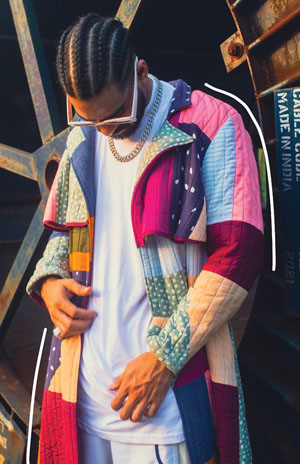
Doodlage, a zero-waste brand out of India, upcycles post-consumer waste and post-cutting scraps into new garments, such as this quilted patchwork trench coat.
Handmade items and crafty looks are all the rage on TikTok. “Whether it’s deconstructing blanks and tapestries and making them into jackets/hoodies or creating patchwork and turning it into shirts and pants, having a one-of-a-kind garment is the style,” says Jeremy Picker, creative director and CEO of apparel design and branded merchandise firm AMB3R Creative.
2. PREPPY & COLLEGIATE LOOKS
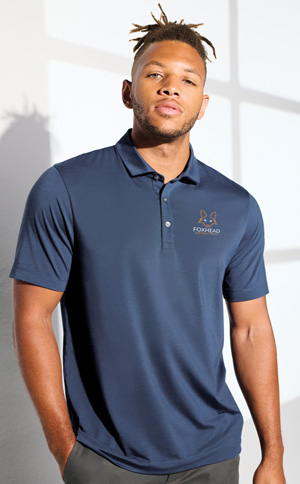
Polo shirts, like this Mercer+Mettle stretch jersey piece, are classic and aspirational in uncertain times.
This style conjures up images of Ivy Leaguers with popped collars and perennial tans – an attractive prospect in these unsettled days. “It’s essentially just a simple, useful, functional look that just feels right,” says Vicki Ostrom. “We’re potentially heading into a recession and costs are high, but a polo is always accessible. Everyone can buy into that look.” The other factor, she says, is the growth of “court sports” like tennis and pickleball. Wearing a polo with a crisp tennis skirt helps you “be part of a club,” Ostrom says.
3. SUBTLE CROP TOPS

Cropped tops, where the hem of the shirt meets the top of the pant, are on trend – as evidenced by this TriDri cropped hoodie.
Cropped tops with a “meet-and-greet length – like 22 inches – where the bottom of the shirt just edges the top of the pant” will be big this year, as will cropped hoodies and fleece, according to Marcus Davis. A recent New York Times feature noted that young people have been wearing crop tops in the office, pairing them with high-waisted skirts or pants and adding a cardigan or blazer for extra coverage.
4. SUSTAINABILITY
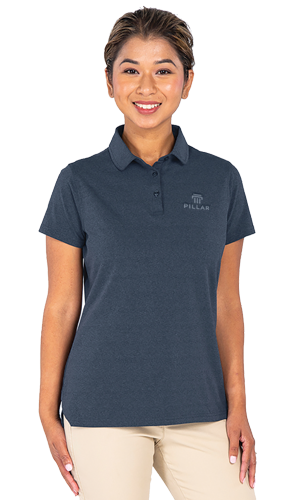
This stretch polo is made of 44% REPREVE recycled polyester as well as regular polyester and spandex.
Eco-friendly materials and responsibly made garments will continue to grow throughout 2023. And more apparel will highlight the sustainability of their product lines. Julie Crawley of Charles River Apparel says the supplier is partnering with Nexgen Packaging to develop sustainable packaging and recycled hangtags. It’s also working with Unifi to add REPREVE, a brand of recycled polyester, to its collection.
5. RICH EARTH TONES
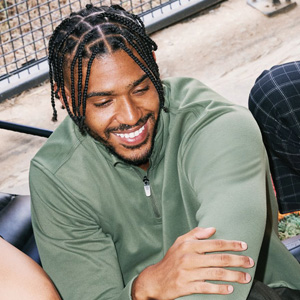
Earthy greens, like this quarter-zip from Champion, are the new neutral.
Though playful and uplifting pinks and reds will be popular this year, many color palettes will stick to browns, tans and other outdoorsy “shades from nature,” says Lauren Cocco of Vantage Apparel. “We’re seeing a continued trend toward earth tones and a spectrum of neutrals becoming more sought after.”